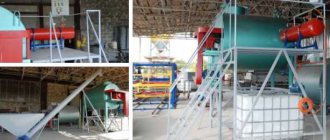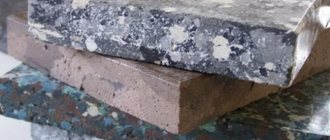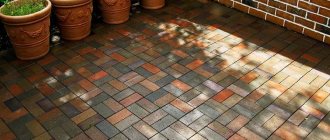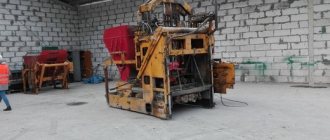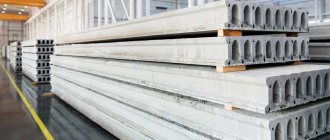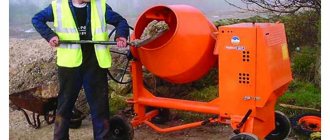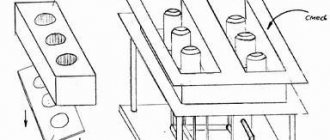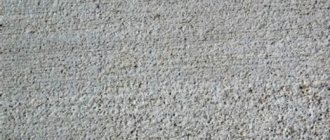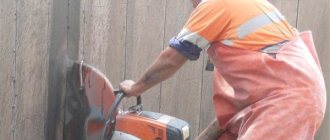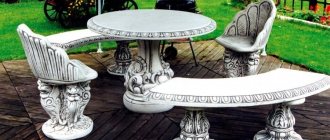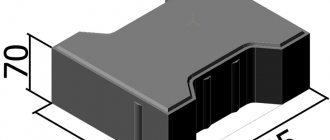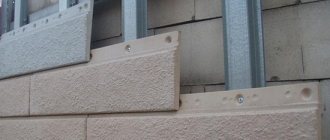Description of technology
The production of washed concrete was established back in the days of the USSR - slabs were made from it for the construction of panel houses. The appearance of such tiles was particularly textured due to the protrusion of the fractional filler on the surface. Later, washed concrete lost some popularity, but now the technique is again beginning to be widely used by builders.
The essence of the technology comes down to creating special conditions for the solution to harden when the mixture matures unevenly. Inside, the material gains strength as usual, but on the surface the process proceeds slowly. This effect can be achieved by using a special gel-like substance called a retarder. The gel enters into a chemical reaction with cement, resulting in a certain thickness of the non-hardening concrete mixture. After this, the viscous mass is washed off with a stream of water, which exposes the filler grains.
Washing concrete with a jet of water
The top decorative layer adheres firmly to the base and does not separate, since the filler is evenly distributed throughout the entire thickness of the concrete and protrudes only partially, by about 40%. The products are formed in formwork, which is removed after the concrete has completely hardened. The result is a rough stone surface that has anti-slip properties. The filler can be:
- pebbles;
- marble;
- granite.
Granite chips for making washed concrete
Washed concrete has many advantages. It is super durable, not subject to wear, and has a very long service life. The material is not afraid of weather disasters, easily tolerates precipitation, frost, heat, and does not deteriorate even from the action of chemicals.
Manufacturing technology of washed (washed) concrete
Featured posts. Published: November 6 There are a number of products of this type on the market.
I have attached documentation for one of them. For experiments, my workshop is at full disposal, we can organize a video conference. I’ll tell you more about microgels. If anyone knows a way other than chalk, please tell me.
Where is it used?
Share message Link to message. Well, why isn’t it interesting? I’m interested.
The classification of concrete additives is quite extensive, but all varieties are divided into two main groups. The second group includes impurities that help optimize the performance characteristics of concrete: frost resistance, water absorption, strength, and corrosion rate.
Published: August 20 Good afternoon. Is this topic still interesting?
Application area
Most often, such concrete is used to create garden paths and sidewalks, elements of building facades, retaining walls, flower beds, garden benches, and trash cans. Using the material you can make a fence, column, stairs and railings, and various decorative elements. Washed concrete is used to finish parking areas and is widely used in landscape and park design.
Small architectural forms for landscape design
Method for producing washed concrete
The production of this material differs little from the production of conventional concrete, although it has its own characteristics. The basis is a mixture of cement and sand with the addition of filler, which is combined with the required amount of water. The specific appearance of the product will depend on the following indicators:
- the height of the filler reaching the surface;
- filler fraction size;
- color scheme of stones.
Slabs made using techVAZON technology
The main difference between the washed concrete technology and the traditional one is the use of a curing retarder, or deactivator. It is applied to the product from a certain side (usually from the outside). If you need to make an object with a complex pattern, the inside of the mold is treated with a deactivator, and then concrete solution is poured into it.
Production of products using the washed method
In order to save expensive white cement and multi-colored pebbles, you need to prepare two concrete mixtures: one of the usual materials to create the base of the product, the other mixture contains beautiful stones or pebbles. The technology for creating washed concrete contains the following processes:
- Preparation of equipment. If these are flat tiles with an upper front surface, then cover the bottom and sides of the molds with regular grease. To form face down, we use special paper. When the textured surface comes into contact with the equipment, cover the surface of the latter with gel. The deactivator is most conveniently applied using a spray bottle, but you can also use a brush.
- Mix the concrete mixture. First, combine the dry ingredients, then gradually pour in the specified amount of water while constantly stirring with a mixer, if a large amount of concrete is being prepared. A small volume can be mixed with a trowel or shovel.
- We distribute the composition into molds and compact it. Products of small thickness are immediately filled with a textured mixture. Thick parts are formed in two passes. First, pour the usual composition into the equipment, level it, and cover the top with a thin layer of the finishing mixture.
- There is another way to invoice a product. The form is filled with ordinary concrete, which must be compacted by vibration or bayonet. Then we scatter the decorative filler over its surface and press it into the concrete.
- We level the open front surface and cover it with gel.
- Next, you need to wait for about 24 hours and you can start separating the stones. The surface treated with gel to a depth of 1 to 8 mm remains soft. Therefore, cement is easily washed out with a stream of ordinary water supplied under pressure. You can also use running water, but then you need to help it with a brush with plastic bristles.
Products made from washed concrete do not require further finishing. They themselves are quite attractive. The main thing is not to miss the flushing deadline. If the equipment is opened ahead of time, the integrity of the product may be compromised, and decorative stones may simply fall off. Delaying the dismantling of the mold will make the process of washing out the cement impossible.
It is worth noting that there are no strict proportions for the consumption of materials that slow down the concrete hardening process. This point can be adjusted empirically. By experimenting with the amount and concentration of the gel, you can obtain solutions with different external effects.
- Exterior finishing
Equipment and materials
For work you will need the following consumables:
- Portland cement M400. The calcium silicate-based substance is flexible, durable, and inexpensive.
- Filler. Most often, cheap pebbles or crushed stone with a fraction of 5–20 mm are used. More expensive and original-looking fillers can be dolomite, cast iron shot, granite, marble, and glass beads.
- Sand. Select the desired shade and fraction, of any quality.
- Water. Regular cold, clean, without additional impurities is suitable.
- Concrete retarder. The most commonly used are “Addition B3 2”, “Cementol Retard”, “Peramin R”, RSB-500. In extreme cases, you can use sugar molasses or whey.
Varnish for retarding the setting of concrete.
Also, to make washed concrete with your own hands, you need to prepare some equipment:
- container for mixing the solution;
- device for spraying retarder;
- spray gun for pump;
- water pump;
- concrete mixer (for small volumes you can mix concrete by hand);
- mold for pouring from plastic, metal;
- trowel for leveling the surface.
A more durable product can be made using a vibrating table. This device will reduce the number of voids in the mixture by expelling excess air and water.
Making concrete tiles on a vibrating table
Concrete mixtures according to GOST 7473-2010
| IN | M | Properties | Gravel | Granite |
| B7.5 | M100 | P4F50W2 | 3 350 | 3 650 |
| B10 | M150 | P4F75W2 | 3 450 | 3 800 |
| B15 | M200 | P4F100W4 | 3 650 | 3 900 |
| B20 | M250 | P4F150W4/6 | 3 750 | 4 050 |
| B22.5 | M300 | P4F200W6 | 3 900 | 4 200 |
| B25 | M350 | P4F200W8 | 4 000 | 4 300 |
| B30 | M400 | P4F300W10/12 | 4 250 | 4 750 |
| B35 | M450 | P4F300W12 | — | 4 900 |
| — | M500 | P4F300W14 | — | 5 400 |
Production of washed concrete
It’s not difficult to make the material at home; you just need to strictly adhere to the technology that has been proven over the years.
Preparation of working solution
First you need to measure a certain amount of all the components of the concrete mixture: 1 part cement, 1-3 parts filler, 1.5 parts clean sand. After combining the dry ingredients, water is added to the mass until it reaches a creamy consistency. For small elements, it is especially important to ensure that the solution does not come out too thick, but for large areas, on the contrary, it is better to prepare a denser mixture.
Preparation of cement mortar with filler
Laying concrete in formwork
After mixing the solution, a concrete curing retarder is sprayed onto the bottom of the mold. Then immediately pour in the solution and level its surface with a trowel, if necessary. When a vibrating table is available, use it to compact the mass. To obtain interesting color effects, you can pour different portions of concrete, pre-colored with dry or liquid pigments.
Demolding process
The finished product can only be removed when the concrete has sufficiently dried. Typically, this period occurs after 20 hours for small objects, after 40–48 hours for large objects. Failure to adhere to the concrete drying time leads to crumbling and spillage of the filler.
Washing the outer concrete layer
The depth of absorption of the retarder gel is 0.2–1 cm. It and the top layer of the solution should be washed off immediately after removing the product from the mold. A water pump or home car wash is ideal for this purpose. The procedure is carried out carefully so as not to damage the incompletely matured composition. The jet is directed onto the product using a spray gun under low or medium pressure, moving in one direction.
If concrete is difficult to wash off, you can additionally use a soft nylon brush. Before starting use, you need to wait 1–4 weeks (depending on the thickness of the layers) until the concrete is completely hardened.
Washing off the top layer using a sprayer
You can make washed concrete yourself even without special knowledge and skills. With its help, you can decorate your garden plot or garden with real architectural compositions, quickly and without extra financial costs.
Concrete
Binder
Note. Regardless of where concrete is made - at a factory or at home - the main factor determining the properties of the mixture is the binder. Consequently, solutions are divided into cement, gypsum, silicate, slag-alkaline, special polymer-cement and combined.
Silicate
- The most popular in our time are cement-based mixtures, from which both monolithic and prefabricated concrete structures and structures are made . Here, Portland cement is most often used as a binder, but in addition to it, pozzolanic and Portland slag cement are also used. In addition, this group includes decorative (white and colored), non-shrink, alumina and tensile cements.
- Concretes based on gypsum are used more as finishing mixtures (figured modeling), but among them gypsum cement, which is highly water-resistant and elastic, is also very popular.
- Polymer cement concrete is made from latexes and water-soluble resins mixed with cement..
- Slag-alkaline concrete is made from solutions of ground slag mixed with alkaline solutions..
- Rarely used silicate concretes are produced using the lime-based autoclave method..
- For the production of special (heat-resistant, acid-resistant) concrete, special binders are used, such as liquid glass, glass-alkaline and slag elements . Of course, the price of such mixtures is quite high, nevertheless, they are in demand.
Washed concrete
Washed blocks
Note. In general, the technology for producing washed concrete consists of washing out the top layer of cement-sand dough, that is, the binder component with part of the aggregate opens up the aggregate of a larger fraction.
This technology is produced by vibration or vibration casting, where liquid components shrink, exposing the texture of natural stone (pebbles, granite or marble). In this case, only its upper part opens - two-thirds of the fraction is absorbed by the solution and is part of the monolith. For more complex geometries, G-05 gel, C-10 varnish and P-07 paper are used, which is more often applicable for smooth surfaces of paving slabs, panels and fences.
You can even make such elements with your own hands - for this, a mold is prepared and a gel is applied to its surface (if the mold is collapsible, then it is assembled) - all this is done at room temperature. After this, the mold is placed on a working vibrating table and filled with the mixture. We set the finished part to harden for one day, and then, under the pressure of compressed air and water, blow off the top layer of dough, which has not yet hardened.
Asphalt
Laying asphalt
Note. All asphalt concrete production technology may differ in purpose and composition. These are all petroleum construction, roofing and road viscous materials, which are manufactured in accordance with GOST 6617, 9548 and 2245, respectively.
In most cases, asphalt is used as a road surface and includes sand, fine crushed stone, mineral powder and, of course, bitumen, which serves as a binding element. Coarse aggregate (crushed stone, gravel), approximately 85% makes up the bulk of asphalt, but the binding element, that is, bitumen, is only 6%. In this case, after mixing, all components must be quickly placed on the surface to be treated.
Any type of asphalt (sandy, fine-grained and coarse-grained) after preparation must be laid immediately (in a hot state), since otherwise it cannot be compacted to the desired state - the mixture is too brittle. However, there are three production methods - hot, warm and cold.
The only difference is that production occurs at one or another temperature level, that is, the temperature at which all components are mixed. If the cooking method is warm or hot, then all the components are mixed while hot, but with the cold method, only one component is heated.
Cement concretes and proportions
Proportions of components according to the brand and grade of concrete
By and large, the technology for producing concrete work depends on the type of element itself, that is, it can be prefabricated or monolithic concrete, which, in turn, differs in density class. As mentioned above, concrete could contribute not only to the strength of the building, but also to its resistance to all battles, including shelling. For general information, the technologies were developed by professors Malyuta I. G. and Shulyachenko A. R.
If you paid attention to the table, you saw that the composition of concrete (proportions of components) is very different from each other in the number of components per cubic meter. Of course, in the private sector you can ignore such standards, however, the instructions require that the composition of the components does not differ from the standards established by GOST 25192-2012 and GOST 7473-2010.
Production of monolithic reinforced concrete structures. Photo
Now let's talk about what is most often used in repair and construction work, that is, how the concrete solution is prepared - however, we have already mentioned that these can be either prefabricated or monolithic structures. In addition to the fact that there are various connecting elements and fillers, there is also strengthening of structures, that is, reinforcement.
| Standard | Norm according to this standard |
| FER 06-01-001-17 | 187kg/m3 |
| FER 06-01-001-16 | 81kg/m3 |
Number of reinforcement per m2
In general, the amount of reinforcement or steel per cubic meter is determined by weight, by the same GOST standards mentioned above, but here you can simply pay attention to the structure of the frame.
Principle of frame installation
Cement-sand mortars for concreting, in addition to a certain fraction of filler, also require reinforcement - in fact, such a frame is responsible for the integrity of the structure in general. That is why, before making prefabricated or monolithic elements from concrete, a frame of reinforcement is assembled, which, in fact, is responsible for the entire structure.
Using an Immersion Vibrator
During the hardening process, pores remain from the mixing water, which significantly reduces the density of the concrete solution, therefore, vibration is performed for prefabricated and monolithic concrete. This process is carried out on vibrating tables (prefabricated structures) and using submersible vibrators with different amplitudes of vibration of the mace.
The vibration amplitude of the vibrator is selected in accordance with the size of the aggregate fraction, so units come in low, medium and high vibration amplitudes.
- The amplitude of the low-frequency instrument is up to 3500 vibrations per minute and is applicable for a fraction of 3-5 mm;
- mid-frequency - from 3500 to 9000 vibrations per minute for a fraction of 1-1.5 mm;
- high-frequency with an amplitude of 10,000-20,000 is used for fine-grained concrete (0.1-1 mm).
